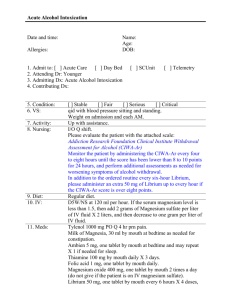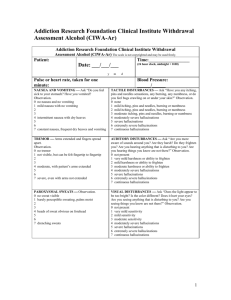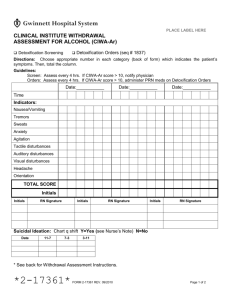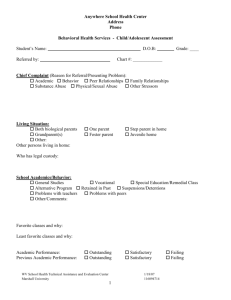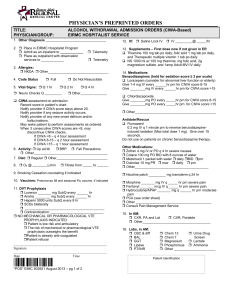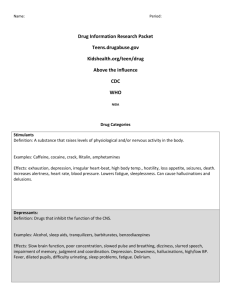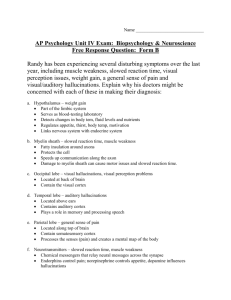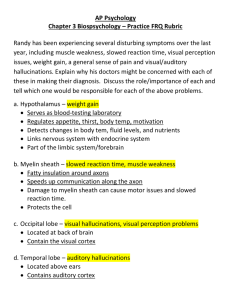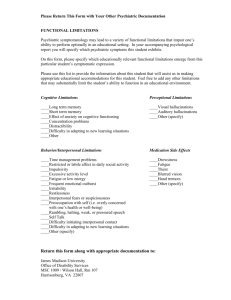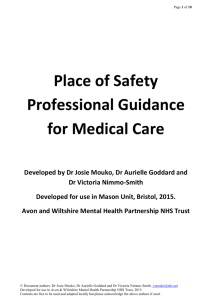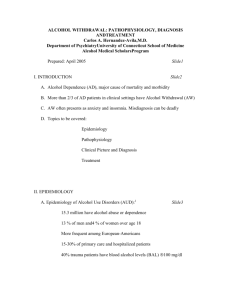Medical Detox
advertisement
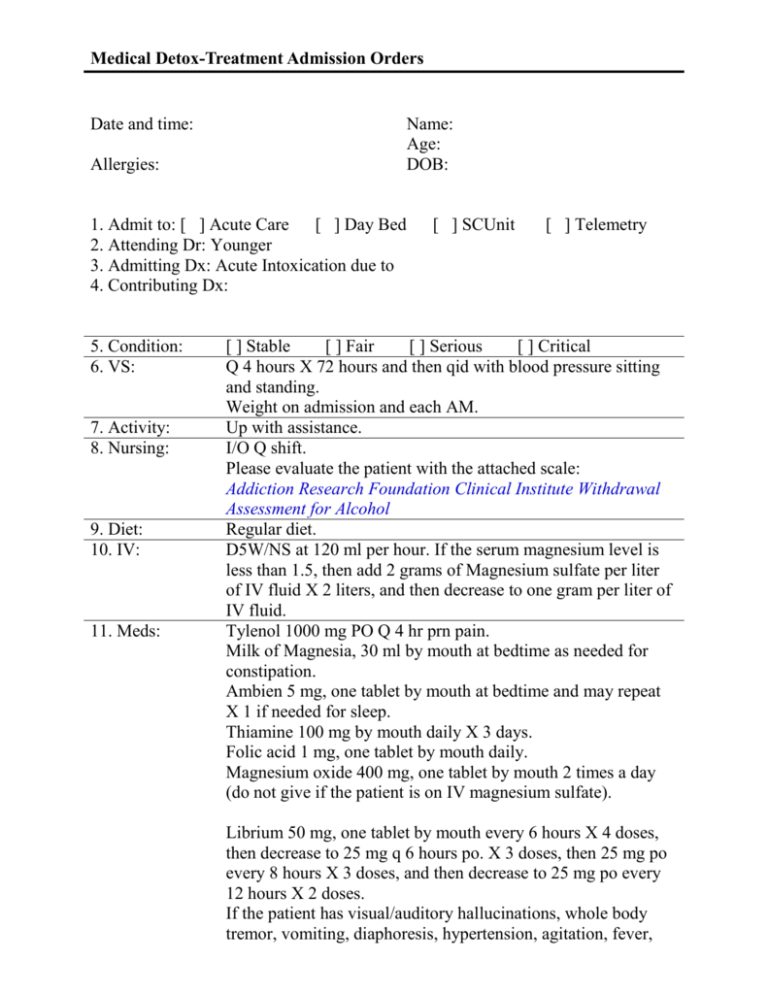
Medical Detox-Treatment Admission Orders Date and time: Name: Age: DOB: Allergies: 1. Admit to: [ ] Acute Care [ ] Day Bed 2. Attending Dr: Younger 3. Admitting Dx: Acute Intoxication due to 4. Contributing Dx: 5. Condition: 6. VS: 7. Activity: 8. Nursing: 9. Diet: 10. IV: 11. Meds: [ ] SCUnit [ ] Telemetry [ ] Stable [ ] Fair [ ] Serious [ ] Critical Q 4 hours X 72 hours and then qid with blood pressure sitting and standing. Weight on admission and each AM. Up with assistance. I/O Q shift. Please evaluate the patient with the attached scale: Addiction Research Foundation Clinical Institute Withdrawal Assessment for Alcohol Regular diet. D5W/NS at 120 ml per hour. If the serum magnesium level is less than 1.5, then add 2 grams of Magnesium sulfate per liter of IV fluid X 2 liters, and then decrease to one gram per liter of IV fluid. Tylenol 1000 mg PO Q 4 hr prn pain. Milk of Magnesia, 30 ml by mouth at bedtime as needed for constipation. Ambien 5 mg, one tablet by mouth at bedtime and may repeat X 1 if needed for sleep. Thiamine 100 mg by mouth daily X 3 days. Folic acid 1 mg, one tablet by mouth daily. Magnesium oxide 400 mg, one tablet by mouth 2 times a day (do not give if the patient is on IV magnesium sulfate). Librium 50 mg, one tablet by mouth every 6 hours X 4 doses, then decrease to 25 mg q 6 hours po. X 3 doses, then 25 mg po every 8 hours X 3 doses, and then decrease to 25 mg po every 12 hours X 2 doses. If the patient has visual/auditory hallucinations, whole body tremor, vomiting, diaphoresis, hypertension, agitation, fever, global confusion, or disorientation, then give the Librium 100 mg IM or po q 6 hours until the severe symptoms clear and restart the Librium tapering schedule. Use Ativan Detoxification Schedule if the patient is > 60 years of age or has documented cirrhosis, esophageal varices, or has liver enzymes that are elevated more than two times the normal level. Ativan 2 mg po q 6 hours X 4 doses, then 2 mg po q 8 hours X 3 doses, then 1 mg po q 6 hours x 4 doses, and then 1 mg po q 8 hours X 3 doses. If symptoms of withdrawal occur with the Ativan protocol, give Ativan 4 mg po q 1-2 hours until the patient is sedated, then restart the tapering schedule. 12. Other Meds: 13. Labs: 14. Other: Both Librium and Ativan can be given IV if the patient can or will not take the medication orally. The IM route can also be used if IV access is not present. For nausea as needed use the following drugs: Reglan 5 to 10 mg IV every 6 hours. Zofran 4 mg IV every 6 hours. The Reglan and the Zofran can be alternated every 3 hours to relieve nausea as needed. CBC, chem 8, calcium, blood alcohol level, protime, LFTs, phosphorous, magnesium, TSH, blood alcohol level, and urine drug screen (if not already done in the ER); repeat CBC, blood alcohol level, chem 8, calcium, LFTs, magnesium, and phosphorous on the AM after admission (with a protime if the 1st one was elevated). EKG on admission; Chest x-ray (PA and lateral) on admission. Call MD if: altered mental status, T 101F or higher, chest pain, pulse < 40 or >130, or the score on the Addiction Research Foundation Clinical Institute Withdrawal Assessment for Alcohol is greater than 20. 15. Consultations: Please consult the Mental Health Center and have a substance abuse counselor evaluate the patient to see if he needs inpatient detoxification in a dedicated alcoholic detoxification center. 16. H&P: Please type up the H&P. ________________________________________________ Signature Addiction Research Foundation Clinical Institute Withdrawal Assessment for Alcohol This scale is not copyrighted and may be used freely. CIWA-Ar Patient:__________________________ Date: ________________ Time: _______________.(24 hour clock, midnight = 00:00) Pulse or heart rate, taken for one minute:_________________________ Blood pressure:______ NAUSEA AND VOMITING -- Ask "Do you feel sick to your stomach? Have you vomited?" Observation. 0 no nausea and no vomiting 1 mild nausea with no vomiting 2 3 4 intermittent nausea with dry heaves 5 6 7 constant nausea, frequent dry heaves and vomiting TACTILE DISTURBANCES -- Ask "Have you any itching, pins and needles sensations, any burning, any numbness, or do you feel bugs crawling on or under your skin?" Observation. 0 none 1 very mild itching, pins and needles, burning or numbness 2 mild itching, pins and needles, burning or numbness 3 moderate itching, pins and needles, burning or numbness 4 moderately severe hallucinations 5 severe hallucinations 6 extremely severe hallucinations 7 continuous hallucinations TREMOR -- Arms extended and fingers spread apart. Observation. 0 no tremor 1 not visible, but can be felt fingertip to fingertip 2 3 4 moderate, with patient's arms extended 5 6 7 severe, even with arms not extended AUDITORY DISTURBANCES -- Ask "Are you more aware of sounds around you? Are they harsh? Do they frighten you? Are you hearing anything that is disturbing to you? Are you hearing things you know are not there?" Observation. 0 not present 1 very mild harshness or ability to frighten 2 mild harshness or ability to frighten 3 moderate harshness or ability to frighten 4 moderately severe hallucinations 5 severe hallucinations 6 extremely severe hallucinations 7 continuous hallucinations PAROXYSMAL SWEATS -Observation. 0 no sweat visible 1 barely perceptible sweating, palms moist 2 3 4 beads of sweat obvious on forehead 5 6 7 drenching sweats VISUAL DISTURBANCES -- Ask "Does the light appear to be too bright? Is its color different? Does it hurt your eyes? Are you seeing anything that is disturbing to you? Are you seeing things you know are not there?" Observation. 0 not present 1 very mild sensitivity 2 mild sensitivity 3 moderate sensitivity 4 moderately severe hallucinations 5 severe hallucinations 6 extremely severe hallucinations 7 continuous hallucinations ANXIETY -- Ask "Do you feel nervous?" Observation. 0 no anxiety, at ease 1 mild anxious 2 3 4 moderately anxious, or guarded, so anxiety is inferred 5 6 7 equivalent to acute panic states as seen in severe delirium or acute schizophrenic reactions HEADACHE, FULLNESS IN HEAD - Ask "Does your head feel different? Does it feel like there is a band around your head?" Do not rate for dizziness or lightheadedness. Otherwise, rate severity. 0 not present 1 very mild 2 mild 3 moderate 4 moderately severe 5 severe 6 very severe 7 extremely severe AGITATION -- Observation. 0 normal activity 1 somewhat more than normal activity 2 3 4 moderately fidgety and restless 5 ORIENTATION AND CLOUDING OF SENSORIUM -- Ask "What day is this? Where are you? Who am I?" 0 oriented and can do serial additions 1 cannot do serial additions or is uncertain about date 2 disoriented for date by no more than 2 6 calendar days 7 paces back and forth during most of the 3 disoriented for date by more than 2 interview, calendar days or constantly thrashes about 4 disoriented for place/or person Total CIWA-Ar Score ______ Rater's Initials ______ Maximum Possible Score 67 The CIWA-Ar is not copyrighted and may be reproduced freely. This assessment for monitoring withdrawal symptoms requires approximately 5 minutes to administer. The maximum score is 67 (see instrument). Patients scoring less than 10 do not usually need additional medication for withdrawal. Sullivan, J.T.; Sykora, K.; Schneiderman, J.; Naranjo, C.A.; and Sellers, E.M. Assessment of alcohol withdrawal: The revised Clinical Institute Withdrawal Assessment for Alcohol scale (CIWA-Ar). British Journal of Addiction 84:13531357, 1989.
